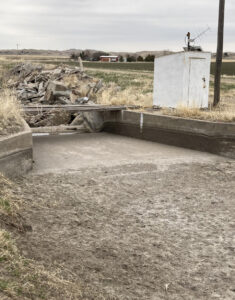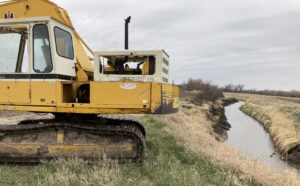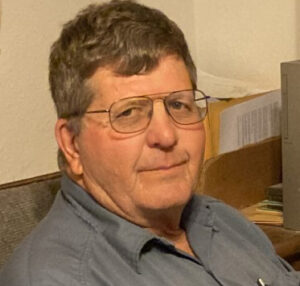The Keith–Lincoln County Irrigation District (KLCID), located in western Nebraska, has been operating since the late 19th century. Aside from a headgate system installed during the 1970s, the canal system used by the KLCID today also dates back to that time. In this interview, we speak with KLCID Board President Mark McConnell about the district’s operations and the challenges of a small irrigation district.
Irrigation Leader: Please tell us about your background and how you came to be in your current position.
Mark McConnell: I’m a director for the district. Our district is pretty small. It covers parts of two counties—Keith and Lincoln. It is governed by an elected three-member board and has a single ditch rider. Each director represents one of the district’s three subdistricts. I have been board president for 4–5 years. I am also an active farmer and a patron of the district. I use the water from our system on my farms. Actually, owning land within the district is a requirement to serve on the board and to have voting authority.
Irrigation Leader: Please tell us about the KLCID.

Mark McConnell: It was established over 100 years ago, and its canal system was built in the late 1800s. Our appropriation dates to 1894 and was obtained during the construction process. The canal system was finished around 1898–99. We’re not a huge district. Over the years, we’ve had around 5,000–6,000 acres. We lost a few in later years—we went through a drastic recertification process during the late 1980s, when the Nebraska Department of Water Resources came in and reviewed which acres were being irrigated and which were not. We lost some eligible irrigated acres and subsequently some of our flow rights after that adjudication. Our current tax base is around 5,600 acres. We rebuilt our headgate system during the mid‑1970s; that was probably the largest improvement we have made to the system. Other than that, our system has remained pretty much the same since we started, and the age of our structures is beginning to show.
Irrigation Leader: What are the major crops that are grown in your district?
Mark McConnell: Predominantly row crops. Corn and soybeans make up 80–90 percent of the acreage; then there is some alfalfa and a little bit of wheat, most of which is not irrigated. There was a time when there were a lot of sugar beets, but we lost all our local processing and shipping facilities, so sugar beets have mainly disappeared.
Irrigation Leader: Would you tell us about the source of your water and the date of your water right?
Mark McConnell: Nebraska’s state law and water rights are based on the principle of first in time, first in right. Our water right was approved on February 2, 1894. We are second in line locally in terms of our right to pull water out of the North Platte River system, which puts us in a strong position. There is one other district, slightly larger than us, whose right dates back a few months earlier. There have been times when we’ve been able to run water in our ditches while other districts have had to shut down for lack of water. Usually, the first thing that people did when they could get a hold of a right of way and get the farmers on board was to apply for a water right so that they could get a good priority date. They usually held their water right by the time they started construction. That was the case with us, too.
All our water comes out of the North Platte River. Kingsley Dam, which forms Lake McConaughy, is not far upstream of us. We are the first district that pulls water below the dam. Lake McConaughy is controlled by Central Nebraska Public Power and Irrigation District (CNPPID), which we have storage water contracts with in addition to our natural flow right established with the State of Nebraska. Our water right is based on natural inflows coming into the west end of Lake McConaughy, as determined by the Nebraska Department of Natural Resources. That’s where we determine our priority. CNPPID has to pass that water through to us and the other local districts below us until our demand calls are met or the available natural flows are used up; then, it gets to store any excess and any water it has priority rights to.
Irrigation Leader: What infrastructure improvements have you done in the past, and what do you aim to do in the future?
Mark McConnell: As I mentioned, the biggest improvement we have made over the life of the system was to our headgate structure. There was originally a sand dike in the river channel that went through a set concrete gates that were nothing more than manual bore–type check structures. The canal operators tried to split the river channel to get enough water to supply the canal. They might pull in 100–150 cubic feet per second (cfs) of water through that main headgate down a lead-in canal to a regulating check, where they would spill some of the water back into the river. That way, they could regulate the water in our main canal system at about 80–90 cfs. They used that for 75–80 years, all the way until the mid‑1970s. It was kind of a mess, since year after year, the sandbank would be washed out by high river flows, leaving the district unable to get water as flows dropped off later in the summer. We’d have to rebuild the dike, which was tough.
In the mid-1970s, the board started a project to completely rebuild and upgrade our gate system. It picked a location further downstream where we could actually bridge the entire river channel and control the whole flow of the river through our gates and our diversion. The district put in a new concrete structure with six automatic gates and a side gate system to control the flow into our main canal system. It was all automated at the time it was built; it was said at the time that we had the best headgate system of any ditch in the state.
We’re still using that structure, which works pretty well, though it requires more maintenance all the time. We’re having some issues with sealing plates under our gates and things on the concrete itself, and our drive system is showing some wear and tear. I actually tried to push a program over the last couple of years to upgrade the control system on the gate operators and link it with a SCADA system that CNPPID uses on all its gates. So far, I’ve kind of gotten shot down on that because it is a costly upgrade. We have abandoned that for the time being and are operating just like we always have. We’re getting to the point where we’re going to have to do some major servicing on it.
We recently had to do some work on our weir, also. A few years ago, it was experiencing quite a bit of concrete erosion. We repaired it rather than replacing it. That’s a critical structure too; if we can’t maintain our weir, we are done.
We have a couple of concrete drops through the system that are starting to crack and really should be replaced. For now, we’re patching them and putting riprap around them. Replacing them will probably cost $20,000–$30,000, and they probably cost $300 when they went in. We’ve been tight enough on cash that we haven’t replaced them either.

Another big issue for us is bridges. Originally, there were a lot of bridges on the system. There were small farms up and down the valley, 80 or 160 acres in size, each with a different owner, and they all had bridges, generally wooden structures with concrete footings. Some of the footings are now in bad shape, and the wooden bridges are basically obsolete, since people are trying to cross them with heavy trucks and equipment. We have been thinning out the bridges all we can; of course, a lot of the ownership has consolidated over the years. We won’t even build a wooden bridge anymore. For the most part, we leave it up to the landowners to put in bridges. We have built a few concrete bridges, which is cost-effective if we can do it ourselves. We can build them for under $10,000. If we hire a contractor, they cost $25,000 or more. Culverts are not usable at many locations either because there is always the danger of plugging them with high-debris storm runoff. At this point, we’ve mostly gotten out of the bridge business.
We are working more closely with the natural resources districts (NRDs), which have stepped up and are now partnering with the surface districts. Originally, the NRDs were only established to monitor and regulate groundwater usage across the state. Now, with the establishment of conjunctive use laws concerning both groundwater and surface water, the NRDs work hand in hand with the Department of Natural Resources to help restore and maintain river flows, which have been affected by groundwater irrigation development over the last 40–50 years. The NRDs have decided that they want to keep these ditches going, because they benefit their goals. They’re able to generate some money and send it back to the ditches. We’re hoping that we’ll be able to generate enough additional money to do some more extensive projects on our structures soon.
Irrigation Leader: What is distinctive about the operations and concerns of a small irrigation district?
Mark McConnell: It mostly comes down to revenue. Even though we’re a relatively small district, we have about 30 miles of canal system to maintain. That’s quite a bit, actually, since our budget is less than $100,000 a year. A big share of the budget goes to labor and equipment maintenance, and not much is left for major projects. There are other funding sources out there that we’ve looked into, but most are designed to be used for efficiency upgrades and not simply maintenance on existing infrastructure.
The other thing is support and usage by the patrons. Ownership of the land base has consolidated quite a bit, and with improvements in irrigation technology, a lot of ground has been converted to pivot irrigation. That’s a good thing, since it has made a huge difference in water conservation, but we find that when people start using pivot systems, a lot of them don’t want to use ditch water anymore. At that point, they no longer want to support the ditch itself, either. They’re bound to support the district whether they’re using the water or not, but it gets a little contentious when we want to spend money. My personal opinion on that is that with the simple filtration systems we’ve set up, we just don’t have any problems using surface water, and there is no real reason not to continue to use ditch water in pivot systems and higher-tech systems. It’s more a question of preference. People want to use well water and say that the ditch is outmoded, but there is no reason they can’t use ditch water. Ditch water is cheaper than groundwater. In reality, we supply the same water as that hole in the ground does. Nevertheless, it’s a tough situation. We’re losing people’s confidence and backing.
Our work with the NRDs has helped us. They are now using these canal systems for recharge flows. In the offseason, when excess natural flows are available, the NRDs have us flow water in our canals with the purpose of soaking it into the ground and returning it to the river system over time, something they are required to do by law in many areas of the state. The NRDs compensate the districts for the amount of water that is put back into the river system. This is a win-win situation for the NRDs and the irrigation districts.
Irrigation Leader: Is there anything else you wanted to share?
Mark McConnell: We’re always fighting the cost side of things and trying to keep our rates down and to supply water as reasonably as possible to our patrons. Times are changing, and it’s getting to be harder all the time, yet there’s no reason these ditches can’t be maintained and continue to be viable well into the future. With the support of the NRDs, I think we are still going to be around for a long time, but it’s a different world than it was even 30–50 years ago. Our intention is to continue on as long as we can. We as a board and I personally will always support trying to keep the KLCID operational.

Mark McConnell is the president of the board of the Keith–Lincoln County Irrigation District. He can be reached at markandsue@hughes.net.
